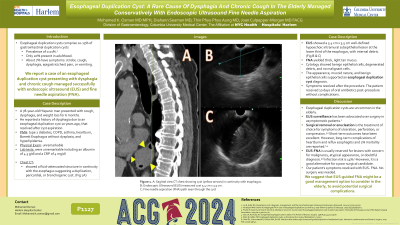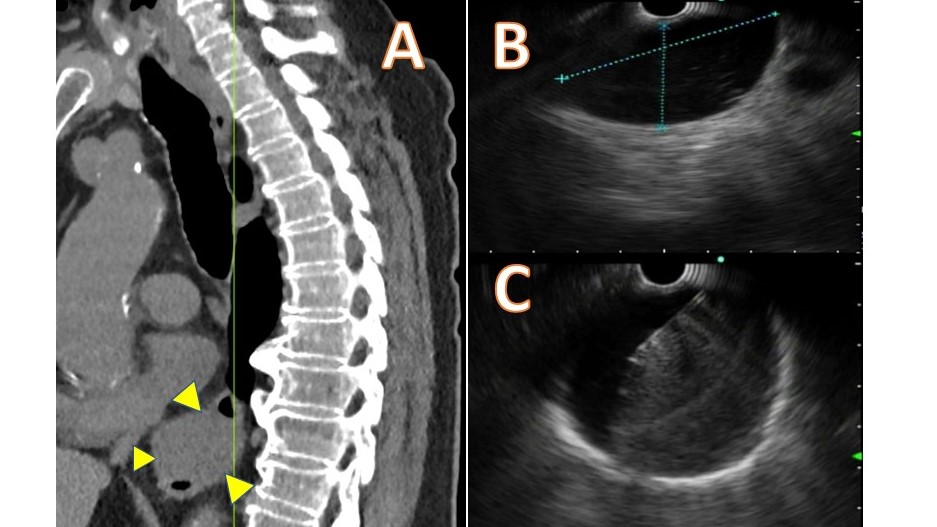Sunday Poster Session
Category: Interventional Endoscopy
P1127 - Esophageal Duplication Cyst: A Rare Cause of Dysphagia and Chronic Cough in the Elderly Managed Conservatively With Endoscopic Ultrasound Fine Needle Aspiration
Sunday, October 27, 2024
3:30 PM - 7:00 PM ET
Location: Exhibit Hall E

Has Audio

Mohamed K. Osman, MD, MPH
NYC Health + Hospitals/Harlem
New York, NY
Presenting Author(s)
Mohamed K.. Osman, MD, MPH, Diahann Seaman, MD, Thin Phyu Phyu Aung, MD, Joan Culpepper-Morgan, MD, FACG
NYC Health + Hospitals/Harlem, New York, NY
Introduction: Esophageal duplication cysts comprise 10-15% of gastrointestinal duplication cysts with a prevalence of 0.01%. Only 20% present in adulthood. About 7% can have symptoms of stridor, cough, dysphagia, epigastric/chest pain, or vomiting. We report a case of an esophageal duplication cyst presenting with dysphagia and chronic cough managed successfully with endoscopic ultrasound (EUS) and fine needle aspiration (FNA).
Case Description/Methods: A 78-year-old Hispanic man presented with cough, dysphagia, and weight loss for 6 months. He reported a history of dysphagia due to an esophageal duplication cyst 10 years ago, that resolved after cyst aspiration. He has an additional medical history of type 2 diabetes, COPD, asthma, heartburn, Barrett Esophagus without dysplasia, and hyperlipidemia. Physical Exam and lab tests were unremarkable including an albumin of 4.3 g/dl and a CRP of 4 mg/dl. Chest CT showed a fluid-attenuated structure in continuity with the esophagus suggesting a duplication, pericardial, or bronchogenic cyst. EUS showed a 5.4 cm x 3.5 cm well-defined hypoechoic intramural subepithelial lesion at the lower third of the esophagus, with internal debris. FNA yielded thick, light tan mucus. Cytology showed benign epithelial cells, degenerated debris, and no malignant cells. The appearance, mucoid nature, and benign epithelial cells supported an esophageal duplication cyst diagnosis. Symptoms resolved after the procedure. The patient received 10 days of oral antibiotics post-procedure without complications.
Discussion: Esophageal duplication cysts are uncommon in the elderly. EUS surveillance has been advocated over surgery in asymptomatic patients. Surgical removal or enucleation is the treatment of choice for symptoms of ulceration, perforation, or compression. Short-term outcomes have been excellent. However, long-term complications of heartburn and reflux esophagitis and 1% mortality are reported. EUS-FNA is usually reserved for lesions with concern for malignancy, atypical appearance, or doubtful diagnosis. Infection risk is 14%. However, it is a good alternative for a poor surgical candidate. Our patient's symptoms resolved with EUS- FNA. No surgery was needed. We suggest that EUS-guided FNA might be a good management option to consider in the elderly, to avoid potential surgical complications.

Disclosures:
Mohamed K.. Osman, MD, MPH, Diahann Seaman, MD, Thin Phyu Phyu Aung, MD, Joan Culpepper-Morgan, MD, FACG. P1127 - Esophageal Duplication Cyst: A Rare Cause of Dysphagia and Chronic Cough in the Elderly Managed Conservatively With Endoscopic Ultrasound Fine Needle Aspiration, ACG 2024 Annual Scientific Meeting Abstracts. Philadelphia, PA: American College of Gastroenterology.
NYC Health + Hospitals/Harlem, New York, NY
Introduction: Esophageal duplication cysts comprise 10-15% of gastrointestinal duplication cysts with a prevalence of 0.01%. Only 20% present in adulthood. About 7% can have symptoms of stridor, cough, dysphagia, epigastric/chest pain, or vomiting. We report a case of an esophageal duplication cyst presenting with dysphagia and chronic cough managed successfully with endoscopic ultrasound (EUS) and fine needle aspiration (FNA).
Case Description/Methods: A 78-year-old Hispanic man presented with cough, dysphagia, and weight loss for 6 months. He reported a history of dysphagia due to an esophageal duplication cyst 10 years ago, that resolved after cyst aspiration. He has an additional medical history of type 2 diabetes, COPD, asthma, heartburn, Barrett Esophagus without dysplasia, and hyperlipidemia. Physical Exam and lab tests were unremarkable including an albumin of 4.3 g/dl and a CRP of 4 mg/dl. Chest CT showed a fluid-attenuated structure in continuity with the esophagus suggesting a duplication, pericardial, or bronchogenic cyst. EUS showed a 5.4 cm x 3.5 cm well-defined hypoechoic intramural subepithelial lesion at the lower third of the esophagus, with internal debris. FNA yielded thick, light tan mucus. Cytology showed benign epithelial cells, degenerated debris, and no malignant cells. The appearance, mucoid nature, and benign epithelial cells supported an esophageal duplication cyst diagnosis. Symptoms resolved after the procedure. The patient received 10 days of oral antibiotics post-procedure without complications.
Discussion: Esophageal duplication cysts are uncommon in the elderly. EUS surveillance has been advocated over surgery in asymptomatic patients. Surgical removal or enucleation is the treatment of choice for symptoms of ulceration, perforation, or compression. Short-term outcomes have been excellent. However, long-term complications of heartburn and reflux esophagitis and 1% mortality are reported. EUS-FNA is usually reserved for lesions with concern for malignancy, atypical appearance, or doubtful diagnosis. Infection risk is 14%. However, it is a good alternative for a poor surgical candidate. Our patient's symptoms resolved with EUS- FNA. No surgery was needed. We suggest that EUS-guided FNA might be a good management option to consider in the elderly, to avoid potential surgical complications.

Figure: A: Sagittal view CT chest showing cyst (yellow arrows) in continuity with esophagus. B: Endoscopic Ultrasound (EUS) measured cyst 5.4 cm x 3.5 cm. C: Fine needle aspiration (FNA) path seen through the cyst
Disclosures:
Mohamed Osman indicated no relevant financial relationships.
Diahann Seaman indicated no relevant financial relationships.
Thin Phyu Phyu Aung indicated no relevant financial relationships.
Joan Culpepper-Morgan indicated no relevant financial relationships.
Mohamed K.. Osman, MD, MPH, Diahann Seaman, MD, Thin Phyu Phyu Aung, MD, Joan Culpepper-Morgan, MD, FACG. P1127 - Esophageal Duplication Cyst: A Rare Cause of Dysphagia and Chronic Cough in the Elderly Managed Conservatively With Endoscopic Ultrasound Fine Needle Aspiration, ACG 2024 Annual Scientific Meeting Abstracts. Philadelphia, PA: American College of Gastroenterology.
